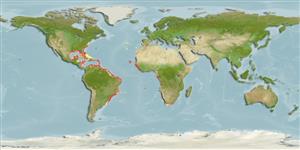>
Holocentriformes (Squirrelfishes, soldierfishes) >
Holocentridae (Squirrelfishes, soldierfishes) > Myripristinae
Etymology: Corniger: Latin, cornus + horn + Latin, gero = to carry (Ref. 45335).
More on author: Agassiz.
Environment: milieu / climate zone / depth range / distribution range
Écologie
marin démersal; profondeur 45 - 275 m (Ref. 7251). Tropical
Western Atlantic: South Carolina, USA to Cuba and Brazil. Eastern Atlantic: St. Helena (Ref. 5288). Eastern Atlantic: Cape Verde Islands (Ref. 94080).
Taille / Poids / Âge
Maturity: Lm ? range ? - ? cm
Max length : 20.0 cm TL mâle / non sexé; (Ref. 7251)
Épines dorsales (Total) : 12; Rayons mous dorsaux (Total) : 14; Épines anales: 4; Rayons mous anaux: 11. Body bright red, unstriped, darker above, with a dark, brownish red are below soft dorsal fin. Preopercle with large spine at angle and smaller stout spines below. Three large, backward-projecting spines below each eye (Ref. 7251).
Inhabits deep rocky slopes (Ref. 7251) and reefs (Ref. 51183).
Life cycle and mating behavior
Maturities | Reproduction | Spawnings | Egg(s) | Fecundities | Larves
Robins, C.R. and G.C. Ray, 1986. A field guide to Atlantic coast fishes of North America. Houghton Mifflin Company, Boston, U.S.A. 354 p. (Ref. 7251)
Statut dans la liste rouge de l'IUCN (Ref. 130435)
Menace pour l'homme
Harmless
Utilisations par l'homme
Pêcheries: d'intérêt potentiel
Outils
Articles particuliers
Télécharger en XML
Sources Internet
Estimates based on models
Preferred temperature (Ref.
123201): 15.3 - 26, mean 20.2 °C (based on 158 cells).
Phylogenetic diversity index (Ref.
82804): PD
50 = 1.0000 [Uniqueness, from 0.5 = low to 2.0 = high].
Bayesian length-weight: a=0.01778 (0.00680 - 0.04650), b=3.02 (2.79 - 3.25), in cm total length, based on LWR estimates for this (Sub)family-body shape (Ref.
93245).
Niveau trophique (Ref.
69278): 3.5 ±0.2 se; based on size and trophs of closest relatives
Résilience (Ref.
120179): Haut, temps minimum de doublement de population inférieur à 15 mois (Preliminary K or Fecundity.).
Fishing Vulnerability (Ref.
59153): Low vulnerability (10 of 100).
Nutrients (Ref.
124155): Calcium = 181 [80, 1,268] mg/100g; Iron = 1.35 [0.59, 3.29] mg/100g; Protein = 17.3 [16.0, 18.6] %; Omega3 = 0.25 [0.09, 0.68] g/100g; Selenium = 81 [39, 175] μg/100g; VitaminA = 12.5 [3.7, 45.7] μg/100g; Zinc = 1.18 [0.72, 1.94] mg/100g (wet weight);
